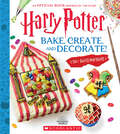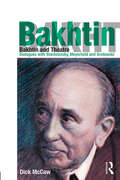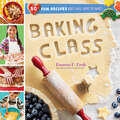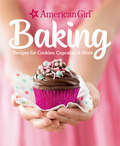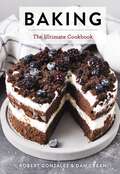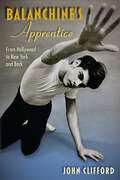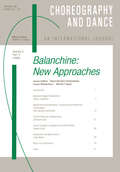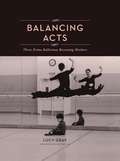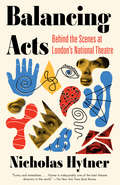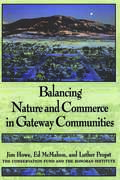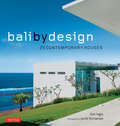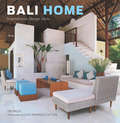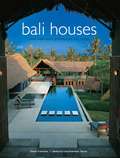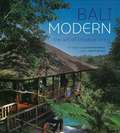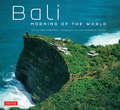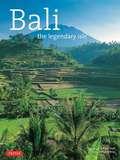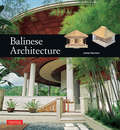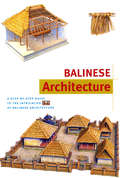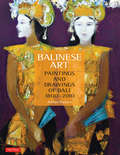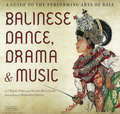- Table View
- List View
Bake It: More Than 150 Recipes for Kids from Simple Cookies to Creative Cakes!
by DKAn all-encompassing baking book for kids aged 9-12 filled with over 150 recipes from simple cookies to creative cakes!Want a baking book filled with mouth-watering recipes that you will actually want to bake? Then this creative cookbook may be what you&’re looking for. Perfect for young bakers aged 9-12, whether you&’re a baking novice or you can ice cupcakes in your sleep, this is a baking book that teaches you the basics as well as challenges you to flex your bread-kneading, meringue-whipping muscles and try out a more technical bake. Celebrate your child&’s creativity as they explore: - Over 150 delicious sweet and savoury recipes to try out - The recipes are written simply and clearly and require readily available ingredients.- Clear and simple photographs for all the step-by-step instructions.- Advice on colours and decorations that complement and finish off all of the baked items.- Advice on how to best present and show off baked goods.By working your way up the levels from basic bread to sophisticated celebration cakes, you&’ll become a more confident baker and will soon be creating inspired baked goods like those seen on TV cooking competition programmes, in vlogger&’s videos, and in baking blogs online. With more than 150 delicious sweet and savoury recipes to try out, you will quickly be able to perfect classic cakes, create pastries from scratch, make biscuits, cheesecakes, macarons, and much more. Be proud of what you produce and get snapping, sharing, and uploading photos faster than the egg timer&’s ping! DK&’s Bake It is stylish, easy-to-follow, and so on trend!This kid&’s baking book covers the latest cooking trends, from pinata cakes and edible flowers to drizzle icing and painted cake. Budding young bakers can explore a plethora of mouth-watering recipes including cookies, bread, pies, tarts, meringues and so much more. Also featuring a handful of no-bake recipes as well as variations on traditional recipes, there is truly something for every child to explore, indulge and enjoy! A must-have baking cookbook for children aged 9-12 years with a love for cooking, who are looking to take their baking skills to the next level, Bake It is the ideal volume to try and test out over a hundred riveting recipes, accompanied by beautiful photographs of the baked items that is sure to engage and inspire budding young chefs.
Bake, Create, and Decorate: 30+ Sweets and Treats (Harry Potter)
by Joanna FarrowCreate delicious cakes, cupcakes, cookies, and other decorative desserts inspired by the Harry Potter films! A companion to the #1 New York Times bestseller The Official Harry Potter Baking Book and The Official Harry Potter Cookbook! Decorate your own magical creations in this official dessert book that's perfect for the youngest fans of the Harry Potter films! This gorgeous book is packed with full-color photography and kid-friendly instructions for how to create 30 cake, cupcake, and cookie designs. Build your own Acromantula out of cupcakes. Design Hogwarts house crest cookies. Frost a cake that looks just like the Knight Bus -- and many more!Each design in the book can be created using simple store-bought cake or cookie mixes. Or whip up your own treats from scratch using the provided basic cake, cookie, and frosting recipes. Plus, assembling cakes and frosting complex designs are made easy for bakers of all ages thanks to the handy templates included at the back of the book.The delicious Wizarding World-themed desserts found in this book are perfect for parties, holidays, movie nights, and more! The perfect book for any beginning baker, aspiring decorator, and Harry Potter fan!
Bakhtin and Theatre: Dialogues with Stanislavski, Meyerhold and Grotowski
by Dick MccawWhat did Bakhtin think about the theatre? That it was outdated? That is ‘stopped being a serious genre’ after Shakespeare? Could a thinker to whose work ideas of theatricality, visuality, and embodied activity were so central really have nothing to say about theatrical practice? Bakhtin and Theatre is the first book to explore the relation between Bakhtin’s ideas and the theatre practice of his time. In that time, Stanislavsky co-founded the Moscow Art Theatre in 1898 and continued to develop his ideas about theatre until his death in 1938. Stanislavsky’s pupil Meyerhold embraced the Russian Revolution and created some stunningly revolutionary productions in the 1920s, breaking with the realism of his former teacher. Less than twenty years after Stanislavsky’s death and Meyerhold’s assassination, a young student called Grotowski was studying in Moscow, soon to break the mould with his Poor Theatre. All three directors challenged the prevailing notion of theatre, drawing on, disagreeing with and challenging each other’s ideas. Bakhtin’s early writings about action, character and authorship provide a revealing framework for understanding this dialogue between these three masters of Twentieth Century theatre.
Baking Class: 50 Fun Recipes Kids Will Love to Bake! (Cooking Class)
by Deanna F. CookFollowing the best-selling book Cooking Class, this delightful baking cookbook for children ages 8–12 features 50 easy-to-follow, kid-friendly recipes. Lively step-by-step photos teach bakers-in-training how to knead dough, make biscuits, decorate cookies, and produce a perfect pie, along with essential skills like following directions and accurately measuring ingredients. Kids will learn to make both sweet and savory treats and will use fresh fruits and vegetables in recipes such as Bursting with Blueberries Muffins, Zombie Zucchini Bread, and Peachy Keen Crumble. Bonus goodie bag stickers, pop-out gift tags, and bake sale signs encourage kids to share their homemade delights with pride. 2017 NPR's Best Books of the Year 2017 IACP Cookbook Award Winner 2017 National Parenting Product Awards Winner 2018 Mom's Choice Award Gold Winner 2019 New York Times "Best Cookbooks for Kids" Also available in this series: Cooking Class and Cooking Class Global Feast!
Baking: Recipes for Cookies, Cupcakes & More (American Girl)
by American GirlThe IBPA Awards winner that’s packed with more than forty delicious, easy-to-follow recipes fit for any occasion—and perfect for every baker-in-progress.It’s easy to understand why baking is so much fun. There’s nothing quite as satisfying as measuring and mixing ingredients, putting dough or batter into a hot oven, watching—and smelling!—the transformation during baking, and finally removing delicious sweets from the oven. But the best part is sharing the treats you made with love with your friends and family. American Girl Baking provides decadent and delightfully simple recipes that everyone will love.Cookies: From cookie flower pops and cinnamon-sugar snickerdoodles to pinwheel icebox cookies to ice cream sandwiches—find something for every craving.Cupcakes: With kid-favorites flavors like PB & J, s’mores and snowball, and more adult flavors like carrot cake, red velvet, and white chocolate and raspberry, there’s something for every family member. Madeleines: Honey or orange, chocolate or vanilla, no matter what flavor they are—madeleines are a delicious and dainty treat!Baking: A wide range of sweets as diverse as chocolate truffles, rocky road fudge, fruity turnovers, caramel-glazed blondies, and everything in between. Whether you follow each recipe step-by-step or add your own unique twist, baking is a great opportunity to let your personality shine and to create mouthwatering goodies.The American Girl Baking book goes with the exclusive line of bakeware products from Williams-Sonoma and American Girl, but these delicious recipes can be made with the utensils you already have in your home.
Baking: The Ultimate Cookbook (Ultimate Cookbooks)
by Robert Gonzalez Dan CreanWith over 300 recipes, Baking: The Ultimate Cookbook provides you with everything you need to know to master the craft of baking!Baking is a rewarding craft. It is also a demanding one that requires precision and flawless technique. Baking: The Ultimate Cookbook provides everything you need to become a master, featuring over 300 recipes tested and authored by professional pastry chefs, insightful breakdowns of essential techniques and key ingredients, and stunning original photography.Inside this book, you will find:300+ recipes tested by award-winning professionals, bringing the very best baked goods from the world&’s cuisines into your homeHundreds of cookies, cakes, pies, and pastries that can satisfy any sweet cravingTips on purchasing and working with ingredients and much moreWhether you&’re trying to perfect a sourdough starter or just eager to soothe a craving for something sweet, Baking: The Ultimate Cookbook ensures you&’re always positioned to succeed.
Balanchine's Apprentice: From Hollywood to New York and Back
by John CliffordA talented young dancer and his brilliant teacher In this long-awaited memoir, dancer and choreographer John Clifford offers a highly personal look inside the day-to-day operations of the New York City Ballet and its creative mastermind, George Balanchine. Balanchine’s Apprentice is the story of Clifford—an exceptionally talented artist—and the guiding inspiration for his life’s work in dance. Growing up in Hollywood with parents in show business, Clifford acted in television productions such as The Danny Kaye Show, The Dinah Shore Show, and Death Valley Days. He recalls the beginning of his obsession with ballet: At age 11 he was cast as the Prince in a touring production of The Nutcracker. The director was none other than the legendary Balanchine, who would eventually invite Clifford to New York City and shape his career as both a mentor and artistic example. During his dazzling tenure with the New York City Ballet, Clifford danced the lead in 47 works, several created for him by Balanchine, Jerome Robbins, and others. He partnered famous ballerinas including Gelsey Kirkland and Allegra Kent. He choreographed eight ballets for the company, his first at age 20. He performed in Russia, Germany, France, and Canada. Afterward, he returned to the West Coast to found the Los Angeles Ballet, where he continued to innovate based on the Balanchine technique. In this book, Clifford provides firsthand insight into Balanchine’s relationships with his dancers, including Suzanne Farrell. Examining his own attachment to his charismatic teacher, Clifford explores questions of creative influence and integrity. His memoir is a portrait of a young dancer who learned and worked at lightning speed, who pursued the calls of art and genius on both coasts of America and around the world.
Balanchine: A special issue of the journal Choreography and Dance
by Robert P. CohanThis detailed portrait of George Balanchine presents new approaches to his choreography. The book examines Balanchine from diverse perspectives and discusses unexplored aspects of his work, such as the notion of Balanchine as an architect, and his experiments with the African-American dance tradition. The articles complement and reinforce each other, taking interdisciplinary perspectives and encouraging a reexamination of, and expansion of, existing opinions.
Balancing Acts
by Lucy GrayThere are few jobs more rarefied or as physically and mentally demanding as prima ballerina. And yet, despite very real professional risks, three dancers from the world-class San Francisco Ballet all decided to have children at the pinnacle of their careers. In Balancing Acts, photographer Lucy Gray takes readers on an unforgettable fourteen-year journey with these ballerinas, capturing their remarkable grit and determination.In dramatic black-and white photography, Gray documents their struggles to balance the demands of family and work--from their tireless preparation in rehearsals and dazzling mastery of craft displayed on stage, to their time spent relaxing at home with family and even while giving birth. In extensive interviews the dancers and their husbands discuss their stories with great candor, providing remarkable insight into the life of a ballerina and the everyday challenges and joys of mothers everywhere.
Balancing Acts: Behind the Scenes at London's National Theatre
by Nicholas HytnerFrom the Tony Award and Laurence Olivier Award-winning former director of London's National Theatre--this is a fascinating, candid, eloquent memoir about his career directing theater, producing films and opera, and working closely with some of the world's most celebrated actors. The list of Nicholas Hytner's accomplishments is long and distinguished: as Artistic Director of London's National Theatre from 2003-2015, he directed and produced a great number of their most popular and memorable plays and musicals, many of which have come to Broadway: Carousel, Richard Bean's One Man, Two Guvnors, David Hare's Stuff Happens among them. He directed both the London and Broadway productions of Miss Saigon, each of which ran for ten years. He directed Alan Bennett's The Madness of George III on both stage and screen. In short: He is one of today's most successful and admired theatrical impresarios. In Balancing Acts, Hytner gives us a detailed behind-the-scenes look at his creative process. From reviving classic musicals and mastering Shakespeare to commissioning new plays, he shows theater making to be a necessarily collaborative exercise, and he writes insightfully about the actors and playwrights he's worked with: Derek Jacobi, Richard Griffiths, Helen Mirren, Maggie Smith, Michael Gambon, Harold Pinter, and Tom Stoppard among them. With a cultural range that spans from The Mikado to The Lady in the Van, Balancing Acts is not only a memoir but a gathering of illuminating notes on the art of directing and a thoughtful meditation on the purpose of theater.
Balancing Nature and Commerce in Gateway Communities
by Edward T. Mcmahon Luther Propst Jim HoweIncreasing numbers of Americans are fleeing cities and suburbs for the small towns and open spaces that surround national and state parks, wildlife refuges, historic sites, and other public lands. With their scenic beauty and high quality of life, these "gateway communities" have become a magnet for those looking to escape the congestion and fast tempo of contemporary American society.Yet without savvy planning, gateway communities could easily meet the same fate as the suburban communities that were the promised land of an earlier generation. This volume can help prevent that from happening.The authors offer practical and proven lessons on how residents of gateway communities can protect their community's identity while stimulating a healthy economy and safeguarding nearby natural and historic resources. They describe economic development strategies, land-use planning processes, and conservation tools that communities from all over the country have found effective. Each strategy or process is explained with specific examples, and numerous profiles and case studies clearly demonstrate how different communities have coped with the challenges of growth and development. Among the cities profiled are Boulder, Colorado; Townsend and Pittman Center Tennessee; Gettysburg, Pennsylvania; Tyrrell County, North Carolina; Jackson Hole, Wyoming; Sanibel Island, Florida; Calvert County, Maryland; Tuscon, Arizona; and Mount Desert Island, Maine.Balancing Nature and Commerce in Gateway Communities provides important lessons in how to preserve the character and integrity of communities and landscapes without sacrificing local economic well-being. It is an important resource for planners, developers, local officials, and concerned citizens working to retain the high quality of life and natural beauty of these cities and towns.
Bali By Design
by Jacob Termansen Kim Inglis[Bali has long been a creative inspiration for the world-providing exciting new design ideas that are emulated today in homes and hotels around the globe.] The open to the elements bathroom with interior courtyard garden, the giant bamboo sofa with handwoven cushion covers, and the garden pavilion or balé with raised platform seating are all examples of concepts that originated on the island.All these-and much more-may be viewed in [Bali By Design provides coverage of the latest and best design work in Bali today. Featuring 25 stunning contemporary homes, it showcases the ideas of a new generation of talented international and Indonesian designers.] Each of these extraordinary houses presents new solutions for age-old challenges-illustrating how stylish modern lifestyles may be achieved through clever architecture and interior design. See the selection of artful furniture and furnishings in open, airy rooms, the inclusion of natural stone in shady courtyards and swimming pools, and the plethora of handcrafted surfaces, objects and artifacts.[Many of these houses explore ways of reducing power consumption for a more sustainable, low-carbon future. Others present a modern urban version of the tropical Bali design style that has its roots in a traditional rural environment. All, however, combine modern technology with exotic local materials-Balinese sandstone, volcanic rock, recycled ulin wood-for breezy indoor-outdoor living.With over 300 stunning photographs by Danish photographer Jacob Termansen and an insightful text by British author Kim Inglis, this book is a fitting testament to the originality and talent of Bali's design world.]
Bali By Design
by Jacob Termansen Kim Inglis[Bali has long been a creative inspiration for the world-providing exciting new design ideas that are emulated today in homes and hotels around the globe.] The open to the elements bathroom with interior courtyard garden, the giant bamboo sofa with handwoven cushion covers, and the garden pavilion or balé with raised platform seating are all examples of concepts that originated on the island.All these-and much more-may be viewed in [Bali By Design provides coverage of the latest and best design work in Bali today. Featuring 25 stunning contemporary homes, it showcases the ideas of a new generation of talented international and Indonesian designers.] Each of these extraordinary houses presents new solutions for age-old challenges-illustrating how stylish modern lifestyles may be achieved through clever architecture and interior design. See the selection of artful furniture and furnishings in open, airy rooms, the inclusion of natural stone in shady courtyards and swimming pools, and the plethora of handcrafted surfaces, objects and artifacts.[Many of these houses explore ways of reducing power consumption for a more sustainable, low-carbon future. Others present a modern urban version of the tropical Bali design style that has its roots in a traditional rural environment. All, however, combine modern technology with exotic local materials-Balinese sandstone, volcanic rock, recycled ulin wood-for breezy indoor-outdoor living.With over 300 stunning photographs by Danish photographer Jacob Termansen and an insightful text by British author Kim Inglis, this book is a fitting testament to the originality and talent of Bali's design world.]
Bali Home
by Luca Invernizzi Tettoni Kim InglisBali is an island paradise that inspires countless dreams of tropical beaches, exotic people and gorgeous views. More than just an increasingly popular tourist destination, Bali is also a global leader in tropical design, showcased in all its glory in Bali Home. Covering over 100 homes, garden estates, hotels, restaurants and more, this book gives a tantalizing glimpse of the latest design trends coming out of Bali. Full-color photography, both of decorative details and architectural concepts, is accompanied by an insightful text that gives attainable interior design tips to tropical dream seekers.
Bali Houses
by Luca Invernizzi Tettoni Gianni FrancioneBali Houses is a beautiful introduction to the contemporary Asian design movement known as "Bali Style." With visually stunning photographs, architect Gianni Francione shows how Balinese designers are updating the traditional aesthetic principles to create a new international flavor. Villas showcasing the characteristic open, panoramic style are now being made with marble and stone. Architects are applying modern techniques to resort bungalows made of customary coconut wood. The author shows how these departures from tradition are influencing everything from interior design to textiles, table settings to furniture. Bali Houses, is perfect for anyone interested in architecture or design.
Bali Living
by Luca Invernizzi Tettoni Kim Inglis Gianni FrancioneFrom the author of the bestselling Bali Houses comes an inspirational new look at Balinese modern architecture and design.Bali Living is a unique selection of private homes, rental properties, restaurant and wedding facilities, a sports complex and villas. Traditional Balinese compound architecture is evident throughout, but most of the buildings included are contemporary structures that reinterpret old forms and materials in new and exciting ways. Glass and metal have replaced alang-alang and bamboo, but in some cases the old materials are referenced and used in new ways. The interiors are highlighted with a great selection of furniture, artwork, sculpture, paintings and more from local Balinese designers and shops. A dreamer's book come true, Bali Living is an inspiration for anyone interested in home design and architecture.
Bali Modern
by Luca Invernizzi Tettoni Gianni FrancioneThe Balinese Style of architecture and interior design is renowned and increasingly popular the world over. A thatched Balinese Bale, overlooking a panorama of rice fields and open to the evening breeze, or a courtyard that combines temple carving with relaxing, recreational lounging space are enduring features of a distinctive "Bali-style". Shimmering pavilions, open verandahs, living rooms that invite the outside landscaping in - all are part of the Balinese tropical living experience This book focuses on these timeless features and shows the new and exciting ways in which they are interpreted. All the contemporary villas, resort bungalows, shops, restaurants and other buildings in the book, most never photographed before, are new additions to the Bali scene. Each is unique, and, most importantly characterized by a distinctly modern feel. Cleaner lines, more imaginative use of space, sharp angles, and the use of stone, concrete and ceramic roof tiles, are increasingly visible along with the coconut wood, teak and thatching.Shot entirely on location, superb color photographs depict the residences set within their natural landscapes; architectural details; and a stunning array of individual interiors. Meticulous text compiled by an expert in tropical design, relates the various stages of the development of this new, international style, and complements the fascinating array of interiors featured
Bali: Morning of the World
by Luca Invernizzi Tettoni Nigel SimmondsThis volume is stunning representation of one of the truly magical islands on Earth. Author Nigel Simmonds takes a personal look at Bali, remembers his first encounters with the island, and gives valuable insight into a fascinating culture that has managed to preserve its elaborate and time-honoured tradiitons against many odds. Soaking up the sun on a beach, visiting shrines and temples, watching traditional dance performances, or simply sitting and taking in the general ambience are all part of the "Bali experience" shared here.
Bali: The Legendary Isle
by R. Ian Lloyd Patrick R. BoozThe tropical island of Bali is a place of extraordinary beauty-and even more extraordinary people. Terraced rice paddies climb up the steep slopes of misty volcanoes like steps reaching to the sky-and waving palms are silhouetted against vast sandy beaches and tropical sunsets that glow with ever-changing colors. Highland volcanic lakes surrounded by lush jungles contrast sharply with the island's busy towns and roads with a multitude of people.In Bali: The Legendary Isle, author Patrick Booz takes you on a guided tour around this Indonesian island paradise. From Bali's fabled temples-with their elaborately carved statues and colorful painted panels-to the bustling village life surrounding them, this photographic journal provides a detailed look at a thriving culture that maintains its freshness and relevance in the modern world.The photographs of National Geographic photographer R. Ian Lloyd present Bali in all its glory-from the ritual celebrations and theatrical performances of a Balinese temple festival to the luxury of the islands renowned resorts. Bali: The Legendary Isle is an unforgettable record of an incomparable island and her people.
Bali: The Legendary Isle
by R. Ian Lloyd Patrick R. BoozThe tropical island of Bali is a place of extraordinary beauty-and even more extraordinary people. Terraced rice paddies climb up the steep slopes of misty volcanoes like steps reaching to the sky-and waving palms are silhouetted against vast sandy beaches and tropical sunsets that glow with ever-changing colors. Highland volcanic lakes surrounded by lush jungles contrast sharply with the island's busy towns and roads with a multitude of people.In Bali: The Legendary Isle, author Patrick Booz takes you on a guided tour around this Indonesian island paradise. From Bali's fabled temples-with their elaborately carved statues and colorful painted panels-to the bustling village life surrounding them, this photographic journal provides a detailed look at a thriving culture that maintains its freshness and relevance in the modern world.The photographs of National Geographic photographer R. Ian Lloyd present Bali in all its glory-from the ritual celebrations and theatrical performances of a Balinese temple festival to the luxury of the islands renowned resorts. Bali: The Legendary Isle is an unforgettable record of an incomparable island and her people.
Balinese Architecture
by Luca Invernizzi Tettoni Bruce Granquist Davison Julian Nengah Enu Mubinas HanafiBalinese style villas and resorts are popping up everywhere-from Ibiza to St Barts to Singapore. But what is Balinese architecture? And why is it so popular today?Traditional Balinese houses, temples and pavilions are designed to allow man to exist in harmony with the natural forces of the universe-reflecting core Balinese beliefs about man's place in relation to the cosmos, the gods, the ancestors, and the world around him. Innovative local and Western architects have been designing resorts and villas on Bali for decades, drawing their inspiration from these local traditions.In this one-of-a-kind book, author Julian Davison provides a comprehensive guide to Balinese architectural forms, the Balinese belief system, the rituals associated with building, the materials and construction techniques, and the intricate ornamentation used. Over 100 watercolor illustrations and photographs provide a clear picture of the island's architecture as well as an eye-opening look at a culture and a people that have captivated the world's imagination.
Balinese Architecture Discover Indonesia
by Julian Davison Bruce GranquistBalinese Architecture is a step-by-step guide to the intricacies of Balinese vernacular architecture, the written word being complemented throughout by watercolor illustrations of different building types, design concepts and construction techniques.
Balinese Art
by Adrian Vickers[Balinese Art is the first comprehensive survey of Balinese painting from its origins in the traditional Balinese village to its present position at the forefront of the high-priced Asian art scene.] Balinese art has been popular and widely collected around the world for many decades. In fact, the contemporary painter who commands the highest prices in Southeast Asia's hot art market is not Chinese but Bali-born Nyoman Masriadi (1973-)-and this book demonstrates that his work draws on a long and deeply-rooted tradition.[This book surveys the art scene in Bali for the past two hundred years. The author shows how Balinese painting has deep local roots and has followed its own distinctive trajectory, yet has been heavily influenced by outsiders.] Indian artistic and religious traditions were introduced to Bali over a thousand years ago through the prism of ancient Javanese culture. Balinese artists and craftsmen have also interacted with other Asian artists, particularly those of China, and later Western artists. From these sources, an aesthetic tradition developed that depicts stories from the ancient Indian epics as well as themes from Javanese mythology and the religious and communal life of the Balinese themselves.Starting with a discussion of the island's aesthetic traditions and how Balinese art should be viewed and understood, this book goes on to present pre-colonial painting traditions, some of which are still practiced in the village of Kamasan-the home of "classical" Balinese art. However, the main focus is the development of new styles starting in the 1930s and how these gradually evolved in response to the tourist industry that has come to dominate the island. [Balinese Art acquaints readers with the masterpieces and master artists of Bali, and the final chapter presents the most important artists who are active today and serves as an introduction to their work.]
Balinese Dance, Drama & Music
by Rucina Ballinger I Wayan Dibia Barbara AnelloThis book is a lavishly illustrated introduction to the most commonly seen forms of traditional performing arts in Bali; gamelan music, dance, drama and puppetry. Ideal reading for visitors to the island as well as for anyone interested in Balinese culture. The book presents the history and function of each type of performance with illustrations and photographs to aid in identification. Introductory sections discuss the way performing arts are learned in Bali and the principal Balinese values that are passed on in these forms, as well as some of the basic religious and cultural tenets that are expressed in the arts and the functions of the forms themselves.This book is enhanced with a bibliography and discography and over 200 photographs and specially prepared watercolors of Balinese performances.
Balinese Dance, Drama & Music
by Rucina Ballinger I Wayan Dibia Barbara AnelloThis book is a lavishly illustrated introduction to the most commonly seen forms of traditional performing arts in Bali; gamelan music, dance, drama and puppetry. Ideal reading for visitors to the island as well as for anyone interested in Balinese culture. The book presents the history and function of each type of performance with illustrations and photographs to aid in identification. Introductory sections discuss the way performing arts are learned in Bali and the principal Balinese values that are passed on in these forms, as well as some of the basic religious and cultural tenets that are expressed in the arts and the functions of the forms themselves.This book is enhanced with a bibliography and discography and over 200 photographs and specially prepared watercolors of Balinese performances.

